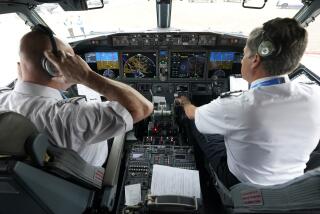Crash Survivor Takes to Air Again--in Her Lucky Seat
- Share via
CHICAGO — Before she got on her flight for Chicago Friday afternoon, Katy Bressieux decided it might be a good idea to stop in the bar at the Omaha airport--just to take the edge off with a nice glass of wine.
Once on board, she checked out the emergency exits, removed the safety information card from the seat pocket in front of her and actually read it, then stared obediently as the flight attendants ran through the pre-takeoff safety briefing that most passengers routinely ignore.
Despite appearances, Bressieux, a 35-year-old development consultant, is no run-of-the-mill, white-knuckled flier. She is one of the survivors of Wednesday’s deadly crash of a crippled United Airlines DC-10 jetliner in Sioux City, Iowa. And United Flight 146, a Boeing 727 bound from Omaha to Chicago, was her first experience in the air since that ordeal.
After the crash, Bressieux’s husband, Jean Pierre, flew to Iowa from their home in Boulder, Colo., to be at her side. Although she was far from panicked, Jean Pierre said it took some coaxing to get his wife on the plane to Chicago, where her parents were anxiously awaiting her arrival.
“At first, she didn’t want to, but then I said ‘to get over this you need to do it right away or you’ll never get over it,’ ” he said.
Suffered Scratch on Head
To be sure, Friday’s flight went much smoother for Bressieux than the previous one, which ended with her strapped upside down in her seat after the DC-10’s fuselage rolled over and broke apart on impact. Her only injury was a scratch on the head.
But it was not exactly an average flight, either. The airline ferried the couple by bus from Sioux City to Omaha. In an eerie coincidence, Bressieux was assigned seat 17B when she checked in at the counter, the same seat she had occupied on Wednesday’s ill-fated flight.
“It’s amazing,” she told the ticket agent. “That’s the seat I was on, and I survived it. It’s a good seat for me.”
On board, she was the center of attention. Other passengers came up to shake her hand, and flight attendants stopped by to chat and deliver bottles of complimentary wine. Reading her first newspaper accounts of the incident, she marveled at the skill of Capt. Alfred C. Haynes, the pilot who kept the plane aloft for 41 minutes after an engine blew up and his hydraulic systems failed.
“We got to drink to this guy, Al Haynes, he’s great,” Bressieux said, clinking her glass against her husband’s.
Despite brief lapses, Bressieux said, she was surprised at how cool and unemotional she remained both before and after the crash. When told to brace herself for the worst, Bressieux calmly removed some pearls and keepsakes from her purse and put them in her pocket so she wouldn’t lose them.
“My mental state through the whole experience has been absolutely clear,” she said. “I was never anxious. I was very aware of everything that was going on. I could see that a lot of people didn’t make it, I saw blood, but it wasn’t computing inside. That’s why I think I may still be in shock.”
Not until hours after the crash, when she tried to sleep, did the impact of the horror she escaped sink in. “I laid down for a couple of hours and I started to have all kinds of flashes, memories, and I got terrified of the idea of going on a plane again,” she recalled. “But I don’t feel that way now. I don’t feel anything in particular. I’m feeling happy. I’m feeling good.”
Any preflight jitters she may have had seemed to melt away en route as Bressieux talked almost non-stop on her way to Chicago. She hardly seemed to notice when the plane touched down smoothly on the runway and taxied to the gate.
Unlike on Wednesday, the only mark that Bressieux would carry away from the airport was a red smear of lipstick on her cheek from her mother’s kiss.
SEATS SAVE LIVES--Firmly anchored seats were cited as an important factor in keeping the death toll lower than initially feared. Page 20
More to Read
Sign up for Essential California
The most important California stories and recommendations in your inbox every morning.
You may occasionally receive promotional content from the Los Angeles Times.













